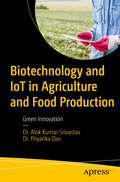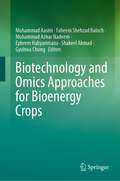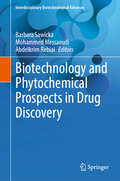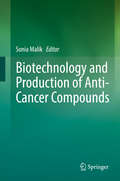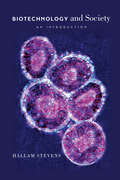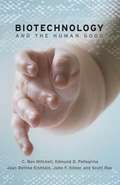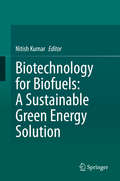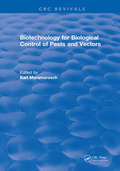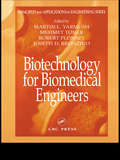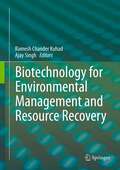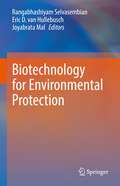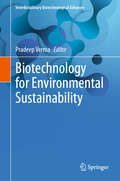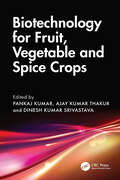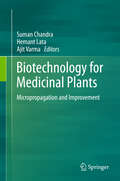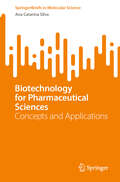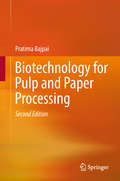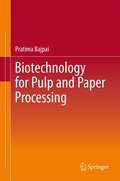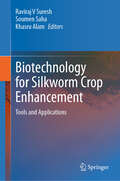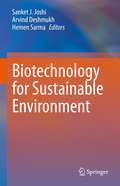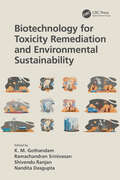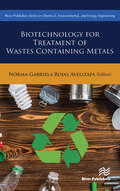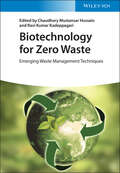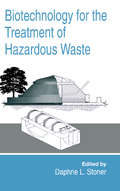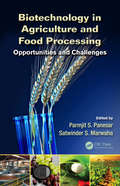- Table View
- List View
Biotechnology and IoT in Agriculture and Food Production: Green Innovation
by Dr. Alok Srivastav Dr. Priyanka DasExplore the transformative intersection of biotechnology and the Internet of Things (IoT) in modern agriculture. This book delves into sustainable solutions and cutting-edge technologies that are revolutionizing the global food production industry. The book is structured to provide an in-depth understanding of how green innovation is reshaping agriculture. Starting with an introduction to sustainability in agriculture, it traces the evolution from traditional farming to smart farming methods, where IoT and Biotechnology come together to optimize crop management, soil health, and resource utilization. Key chapters include the role of IoT in precision farming, biotechnology advancements like CRISPR and GMOs, and their integration for improved crop resilience, pest control, and water management. The synergy between IoT's real-time data capabilities and biotechnology's genetic innovations is highlighted in smart greenhouses, vertical farming, and climate-resilient agriculture. Other critical topics include reducing food waste through technology, the role of AI and machine learning in agricultural practices, blockchain for supply chain transparency, and Biotech's impact on livestock management. Ethical considerations, regulatory frameworks, and green finance opportunities are also addressed, alongside future trends like 5G, drones, and synthetic biology. You will gain a comprehensive view of how biotechnology and IoT are driving sustainable agricultural practices, fostering innovation, and offering solutions to global food security challenges. The book offers practical insights into the future of farming and policy recommendations to ensure a sustainable, tech-driven agricultural future. You Will • Learn how data analytics, AI, and biotech innovations work together in precision farming, optimizing resource usage, improving yields, and addressing environmental challenges • Discover innovative solutions for sustainable food production, including smart irrigation systems, IoT-enabled greenhouses, vertical farming, and biotechnological methods for improving soil health and reducing food waste • Understand the ethical concerns, privacy issues, and regulatory frameworks that govern the use of IoT and biotechnology in agriculture Who Is This Book For Readers with a foundational understanding of agriculture, technology, or sustainability, though no specialized expertise is required. Beginners with an interest in how technology is reshaping food production can grasp the concepts, as the book breaks down complex topics into accessible language. A basic familiarity with IoT and biotech will enhance the learning experience but is not essential for following the book&’s key ideas.
Biotechnology and Omics Approaches for Bioenergy Crops
by Shakeel Ahmad Ephrem Habyarimana Gyuhwa Chung Faheem Shehzad Baloch Muhammad Azhar Nadeem Muhammad AasimThis edited book summarizes the efforts made to develop sustainable bioenergy production through different generations. The topics included in the book cover information about different bioenergy crops, their classification and use as biofuel, agronomic practices to improve biomass yield, classic breeding techniques, genetic diversity, current status and future perspective of bioenergy crops in the omics era. It also discusses application of modern biotechnological and molecular biotechnological techniques for the improvement of bioenergy crops this having enhanced biomass and plant based products. The book explores growing biofuel crops and their impact on environment, bioethics and biosafety issues related to the modern approaches. Another important aspect is the incorporation of nanotechnology for bioenergy crops and biofuel production. All book chapters are contributed renowned researchers in their respective field. This is a unique book covering the bioeneragy crops in the modern omics era. The book is useful for the researchers and post-graduate students to guide them in the field of bioenergy crops.
Biotechnology and Phytochemical Prospects in Drug Discovery (Interdisciplinary Biotechnological Advances)
by Barbara Sawicka Mohammed Messaoudi Abdelkrim RebiaiThis book is a comprehensive exploration of the multifaceted role of phytochemicals in contemporary drug discovery and biotechnology. Comprising eleven insightful chapters, it navigates through the historical roots, current applications, and future possibilities of harnessing plant-derived compounds for medicinal advancements. The initial chapters introduce phytochemicals and their historical significance in traditional medicine, highlighting the scientific validation offered by phytochemistry and pharmacology. The subsequent chapters delve into the incorporation of biotechnology into phytochemical synthesis, focusing on metabolic engineering, synthetic biology, and plant tissue culture to enhance efficiency and reduce environmental impact. The integration of nanomaterial synthesis with medicinal plant extracts is explored for its potential in biomedical applications, such as targeted drug delivery. A thorough examination of bioactive properties of secondary metabolites in unripe fruit extracts reveals their role in immune enhancement, alongside factors affecting bioactive compound content. Advanced analytical techniques crucial to drug discovery are discussed, including "green extraction" and modern methods like high-performance liquid chromatography (HPLC) and gas chromatography (GC) for phytochemical purification and identification. The COVID-19 pandemic has highlighted challenges and strategies in drug discovery, with computational biology advancing molecular target identification and innovative screening methodologies. The exploration of mineral profiling in medicinal plants underscores its importance for human health, detailing methods to identify essential and harmful elements, and noting the nutritional value of these plants. The penultimate chapter addresses future opportunities and challenges in using medicinal plants for drug development, spotlighting India's contributions to global pharmaceutical needs. The final chapter examines phytochemicals as alternative therapeutics against SARS-CoV-2, highlighting antiviral properties and the novel concept of molecular plant farming for vaccine development. This book is a comprehensive resource for those interested in phytochemistry, biotechnology, and pharmacology, elucidating the role of plant-derived chemicals in contemporary medicine and technology.
Biotechnology and Production of Anti-Cancer Compounds
by Sonia MalikThis book discusses cancers and the resurgence of public interest in plant-based and herbal drugs. It also describes ways of obtaining anti-cancer drugs from plants and improving their production using biotechnological techniques. It presents methods such as cell culture, shoot and root culture, hairy root culture, purification of plant raw materials, genetic engineering, optimization of culture conditions as well as metabolic engineering with examples of successes like taxol, shikonin, ingenol mebutate and podophylotoxin. In addition, it describes the applications and limitations of large-scale production of anti-cancer compounds using biotechnological means. Lastly, it discusses future economical and eco-friendly strategies for obtaining anti-cancer compounds using biotechnology.
Biotechnology and Society: An Introduction
by Hallam StevensWith Biotechnology and Society, Hallam Stevens offers an up-to-date primer to help us understand the interactions of biotechnology and society and the debates, controversies, fears, and hopes that have shaped how we think about bodies, organisms, and life in the twenty-first century. Stevens addresses such topics as genetically modified foods, cloning, and stem cells; genetic testing and the potential for discrimination; fears of (and, in some cases, hopes for) designer babies; personal genomics; biosecurity; and biotech art. Taken as a whole, the book presents a clear, authoritative picture of the relationship between biotechnology and society today, and how our conceptions (and misconceptions) of it could shape future developments. It is an essential volume for students and scholars working with biotechnology, while still being accessible to the general reader interested in the truth behind breathless media accounts about biotech’s promise and perils.
Biotechnology and the Human Good
by Jean Bethke Elshtain Scott B. Rae C. Ben Mitchell Edmund D. Pellegrino John F. KilnerSome of humankind's greatest tools have been forged in the research laboratory. Who could argue that medical advances like antibiotics, blood transfusions, and pacemakers have not improved the quality of people's lives? But with each new technological breakthrough there comes an array of consequences, at once predicted and unpredictable, beneficial and hazardous. Outcry over recent developments in the reproductive and genetic sciences has revealed deep fissures in society's perception of biotechnical progress. Many are concerned that reckless technological development, driven by consumerist impulses and greedy entrepreneurialism, has the potential to radically shift the human condition -- and not for the greater good. Biotechnology and the Human Good builds a case for a stewardship deeply rooted in Judeo-Christian theism to responsibly interpret and assess new technologies in a way that answers this concern. The authors jointly recognize humans not as autonomous beings but as ones accountable to each other, to the world they live in, and to God. They argue that to question and critique how fields like cybernetics, nanotechnology, and genetics might affect our future is not anti-science, anti-industry, or anti-progress, but rather a way to promote human flourishing, common sense, and good stewardship. A synthetic work drawing on the thought of a physician, ethicists, and a theologian, Biotechnology and the Human Good reminds us that although technology is a powerful and often awe-inspiring tool, it is what lies in the heart and soul of who wields this tool that truly makes the difference in our world.
Biotechnology for Biofuels: A Sustainable Green Energy Solution
by Nitish KumarThe depletion of petroleum-derived fuel and environmental concerns have prompted many millennials to consider biofuels as alternative fuel sources. But completely replacing petroleum-derived fuels with biofuels is currently impossible in terms of production capacity and engine compatibility. Nevertheless, the marginal replacement of diesel with biofuel could delay the depletion of petroleum resources and abate the radical climate change caused by automotive pollutants. Energy security and climate change are the two major driving forces for worldwide biofuel development, and also have the potential to stimulate the agro-industry. The development of biofuels as alternative and renewable sources of energy has become critical in national efforts towards maximum self-reliance, the cornerstone of our energy security strategy. At the same time, the production of biofuels from various types of biomass such as plants, microbes, algae and fungi is now an ecologically viable and sustainable option. This book describes the biotechnological advances in biofuel production from various sources, while also providing essential information on the genetic improvement of biofuel sources at both the conventional and genomic level. These innovations and the corresponding methodologies are explained in detail.
Biotechnology for Biological Control of Pests and Vectors
by Karl MaramoroschThis book describes new strategies being used to combat disease agents and invertebrate pests. Outstanding experts from the United States, Belgium, China, Guatemala, Japan, Philippines, Singapore, and Thailand have contributed chapters that cover the latest achievements in genetic engineering, emphasizing the microbial and viral biological control agents that can provide environmentally safe, economical control systems. Topics discussed include genetic engineering of Bacillus thuringiensis and B. sphaericus, the development of insect resistance to microbial biocontrol agents, engineering of baculoviruses and nematodes, bioengineering of plants, plant transformation by particle bombardment, fusion of cultured insect cells, new immunodiagnostic assays and control measures against parasitic human diseases, and genetically engineered microbial agents for malaria control. The book also presents improved mass production procedures of microbial and viral biocontrol agents, as well as regulatory and environmental aspects of genetically engineered biocontrol agents. Biotechnology for Biological Control of Pests and Vectors will provide a valuable reference for researchers and students of biological control, microbiology, virology, and molecular biology.
Biotechnology for Biomedical Engineers (Principles and Applications in Engineering)
by Martin L. Yarmush Joseph D. Bronzino Mehmet Toner Robert PlonseyWith the advent of recombinant DNA technology, monoclonal antibody technology, and new technologies for studying and handling cells and tissues, the field of biotechnology has undergone a tremendous resurgence in a wide range of applications pertinent to industry, medicine, and science in general. A volume in the Principles and Applications in Engi
Biotechnology for Environmental Management and Resource Recovery
by Ajay Singh Ramesh Chander KuhadVarious types of secondary agriculture and forestry wastes represent valuable resource materials for developing alternate energy as biofuels and other value added products such as sugars, phenols, furans, organic acids, enzymes and digestible animal feed etc. However, if not managed properly, waste material and environmental contaminants generated by various industries such as food and feed, pulp and paper and textile may lead to severe environmental pollution. The energy, food and feed demand necessitate developing simple and economically viable technologies for environmental management and resource recovery. Microorganisms and their enzymes contribute significantly in utilization of plant residues, resource recovery and eventually in pollution mitigation. "Biotechnology for Environmental Management and Resource Recovery" presents a comprehensive review of selected research topics in a compendium of 16 chapters related to environmental pollution control and developing biotechnologies in agro-ecosystem management and bioconversion of agro-residues (lignocellulosics) into biofuels, animal feed and paper etc. This book provides a valuable resource for reference and text material to graduate and postgraduate students, researchers, scientists working in the area of microbiology, biotechnology, and environmental science and engineering.
Biotechnology for Environmental Protection
by Joyabrata Mal Eric D. van Hullebusch Rangabhashiyam SelvasembianThis book covers broader application of biotechnology for the protection of environment through different bioremediation and biodegradation techniques developed for removal of environmental contaminants including the recently discovered contaminants. The book offers a comprehensive overview of environmental pollutants including their fate, behavior, environmental and associated health risks. It is useful reading material for postgraduate and graduate students of environmental biotechnology, environmental microbiology and ecology. Young researchers also find the chapters useful understanding the latest developments.
Biotechnology for Environmental Sustainability (Interdisciplinary Biotechnological Advances)
by Pradeep VermaThis book covers the broader application of environmental biotechnology for protecting the environment through different bioremediation and biodegradation techniques framed toward removing environmental contaminants, including emerging contaminants. The extensive range of environmental pollutants, which may be organic or inorganic, including toxic heavy metals, radionuclides, synthetic organic dyes, organic compounds, endocrine-disrupting chemicals, pharmaceuticals, and personal care products, etc., continue to pose a threat to human health and ecosystem functioning. The book covers a comprehensive overview of environmental pollutants, including their fate, behavior, and environmental and health risks associated with them. It describes the utilization of bioremediation and phytoremediation processes to provide a superior alternative removal and detoxification of such toxic environmental pollutants directed toward managing ecosystems. It includes an overview of gene modification and omics technology for environment management for the aesthetic approaches to environmental clean-up. Moreover, the book discusses resource recovery from waste using such technologies, which increases the feasibility of the process. Additionally, the book is designed to provide awareness among its readers about major environmental issues like pollution and its management and control through biotechnological means to promote the sustainable development of our society with minimal environmental impact. It also provides technical content regarding the mechanism of bioremediation, biodegradation, and phytoremediation and their field applicability, along with an overview of emerging pollutants and gene modification techniques for remediation applications.
Biotechnology for Fruit, Vegetable and Spice Crops
by Pankaj Kumar Ajay Kumar Thakur Dinesh Kumar SrivastavaBiotechnology has revolutionized horticulture by enhancing the productivity, resilience and nutritional quality of fruit, vegetable and spice crops. This comprehensive volume provides an in-depth exploration of cutting-edge biotechnological advancements that are reshaping horticultural science. From genomics-driven crop improvement to the development of functional foods, this book presents a meticulously curated compilation of research and methodologies addressing key challenges and opportunities in modern horticulture. By integrating molecular techniques, plant–microbe interactions and bioprocess innovations, this book provides a unique perspective on sustainable and precision-driven horticultural practices.Key Features Insights into genomic approaches for understanding abiotic stress tolerance and developing climate-resilient varieties. Advances in tissue culture, marker-assisted selection and genome editing for apple, grapevine and potato breeding. Molecular and biocontrol strategies for tackling major threats, such as root rot disease in apples. Applications of soilless cultivation techniques and plant growth-promoting rhizobacteria (PGPR) to optimize crop yield and quality. Biotechnological tools for developing probiotic-enriched fruits and vegetables and the valorization of non-grape fruit wines. With contributions from leading researchers, this book serves as an essential reference for graduate students, academics and professionals in plant biotechnology, horticulture and food science. It provides a valuable resource for those seeking to harness the power of biotechnology to drive sustainable innovation in horticultural crop production.
Biotechnology for Medicinal Plants: Micropropagation and Improvement
by Ajit Varma Suman Chandra Hemant LataPlant-based medicines play an important role in all cultures, and have been indispensable in maintaining health and combating diseases. The identification of active principles and their molecular targets from traditional medicine provides an enormous opportunity for drug development. Using modern biotechnology, plants with specific chemical compositions can be mass propagated and genetically improved for the extraction of bulk active pharmaceuticals. Although there has been significant progress in the use of biotechnology, using tissue cultures and genetic transformation to investigate and alter pathways for the biosynthesis of target metabolites, there are many challenges involved in bringing plants from the laboratory to successful commercial cultivation. This book presents the latest advances in the development of medicinal drugs, including topics such as plant tissue cultures, secondary metabolite production, metabolomics, metabolic engineering, bioinformatics and future biotechnological directions.
Biotechnology for Pharmaceutical Sciences: Concepts and Applications (SpringerBriefs in Molecular Science)
by Ana Catarina SilvaThis book provides a compact and straightforward overview of the main concepts and applications of Pharmaceutical Biotechnology. The author collates lecture notes on Pharmaceutical Biotechnology to introduce the topic to graduate students in the fields of Pharmaceutical Sciences, Biochemistry, Biotechnology and Industrial Biotechnology, Microbiology, and Medicinal Chemistry. The book starts with an overview of the biotechnological processes needed to develop biological and biosimilar medicines. Next, the author addresses the development and use of advanced therapy medicinal products (ATMPs), including topics such as cell and gene therapies, regenerative medicine and the regulatory issues of biological medicines and ATMPs. Finally, the author explores the limitations of administering biopharmaceuticals, discussing protein and nucleic acid stability issues, potential routes of administration and strategies for improving the bioavailability of biologics and ATMPs. This book captures the latest developments in the field and offers a practical perspective on the topic, serving as a valuable introduction resource not only for graduate students but also for researchers. The basis of the English translation of this book, originally in Portuguese, was facilitated by artificial intelligence. The content was later revised by the author for accuracy.
Biotechnology for Pulp and Paper Processing
by Pratima BajpaiThe book provides the most up-to-date information available on various biotechnological processes useful in the pulp and paper industry. The first edition was published in 2011, covering a specific biotechnological process or technique, discussing the advantages, limitations, and prospects of the most important and popular processes used in the industry. Many new developments have taken place in the last five years, warranting a second edition on this topic. The new edition contains about 35% new material covering topics in Laccase application in fibreboard; biotechnology in forestry; pectinases in papermaking; stickies control with pectinase; products from hemicelluloses; value added products from biorefinery lignin; use of enzymes in mechanical pulping.
Biotechnology for Pulp and Paper Processing
by Pratima BajpaiThis book provides the most up-to-date information available on various biotechnological processes useful in the pulp and paper industry. Each of the twenty chapters covers a specific biotechnological process or technique, discussing the advantages, limitations, and future prospects of the most important and popular processes used in the industry. Topics covered include tree improvement, pulping, bleaching, deinking, fiber modification, biosolids management, and biorefining.
Biotechnology for Silkworm Crop Enhancement: Tools and Applications
by Raviraj V Suresh Soumen Saha Khasru AlamThe book introduces readers to the latest developments in biotechnological methods used for improving the cultivation of silkworms. The text focuses on implementing biotechnological approaches, ranging from basic to advanced techniques, on enhancing silk production, increasing abiotic stress resilience, improving disease tolerance, and developing resistance in silkworm crops. With the current climate crisis and growing demand for high-quality silk, biotechnological applications have become essential in addressing the urgent need to increase silk production. The field of sericulture has made significant breakthroughs, such as identifying DNA markers, linkage association, genome-wide association studies, generating mutants, and introducing transgenic silkworms. Developing silkworms with improved cocoon yield and disease resistance is crucial to boost silk production. The book covers fundamental principles and recent advancements and delves into various methodologies employed inseri-biotechnology for improving silkworm crops. These methodologies include next-generation sequencing for DNA sequencing, using molecular markers to enhance abiotic stress tolerance (specifically high temperature and humidity conditions), expression analysis, RNA interference, gene knockout approaches to bolster disease resistance, and transcriptomics to enhance economically significant parameters such as silk content. The book explains these topics in detail and includes contemporary research appraisals, extensive discussions, and an evaluation of the benefits and risks associated with the use of biotechnological tools. This book serves as an invaluable reference for researchers and academics in biotechnology, molecular biology, and sericulture while also serving as an informative starting point for budding researchers.
Biotechnology for Sustainable Environment
by Hemen Sarma Sanket J. Joshi Arvind DeshmukhThis book brings together the most recent advances from leading experts in the burgeoning field of environmental biotechnology. The contributing chapters adopt a multidisciplinary approach related to environmental aspects of agriculture, industry, pharmaceutical sciences and drug developments from plant and microbial sources, biochemical chemical techniques/methods/protocols involved in different areas of environmental biotechnology. Book also highlights recent advancements, newly emerging technologies, and thought provoking approaches from different parts of the world. It also discusses potential future prospects associated with some frontier development of biotechnological research related to the environment. This book will be of interest to teachers, researchers, biotechnologists, capacity builders and policymakers, and will serve as additional reading material for undergraduate and graduate students of biotechnology, microbiology and environmental sciences.
Biotechnology for Toxicity Remediation and Environmental Sustainability
by Shivendu Ranjan Nandita Dasgupta K. M. Gothandam Ramachandran SrinivasanEnvironmental issues such as ozone layer depletion, overpopulation, biodiversity loss, global warming, natural resource depletion, and so on affect every organism on the planet somehow. Environmental biotechnology applications can help to protect and restore the quality of the environment. The goal is to use biotechnology with other technologies and safety procedures to prevent, arrest, and reverse environmental degradation. Environmental biotechnology is one of the most rapidly expanding and practically useful scientific fields. Biochemistry, physiology and genetic research of microorganisms can be converted into commercially available technologies for reversing and preventing further deterioration of the earth's environment. Solid, liquid, and gaseous wastes can be altered either by recycling new by-products or by purifying to make the end product less harmful to the environment. Biotechnology for Toxic Remediation and Environmental Sustainability discusses the removal of pollutants by absorption techniques and recycling wastewater into valuable by-products and biofuels by microorganisms. Moreover, this book also addresses corrosion prevention by green inhibitors, uses electrochemical systems for renewable energy and waste recycling using microbes, and recent food safety and security trends in the food microbiome. On the other hand, this book also discusses therapy and treatments against antibiotic-resistant bacteria, anti-cancer and pharmacological properties of thymoquinone and preventive properties of zinc nanoparticles against stress-mediated apoptosis in epithelial cells. Features Covers all aspects of Biotechnological application in the environment Discusses sustainable technology for the wastewater treatment and value-added products from wastewater Focuses on research activities Green corrosion inhibitors, bio-electrochemical systems, food safety and security, and antimicrobial resistance The book is a valuable resource for the undergrad and graduate students, doctoral and post-doctoral scholars, industrial personnel, academicians, scientists, researchers, and policymakers involved in understanding and implementing applications of biotechnology for environmental toxic remediation.
Biotechnology for Treatment of Residual Wastes Containing Metals
by Norma Gabriela Rojas-AvelizapaBiotechnology for Treatment of Wastes Containing Metals addresses various aspects related to different wastes that have a metallic content and represent a serious risk for the environment and human health. These wastes, due to their physical and chemical characteristics, have been the object of studies which have led to the development of different technologies in recycling, reuse or adequate disposal, biotechnology being one of these alternatives. Biotechnology offers a range of options for the treatment of types of waste using microorganisms, biomass and their by-products. The mechanisms involved in these waste treatment processes are diverse and complex, and its optimization and efficiency is multifactorial.This text contains nine chapters related to the problem of the metal contamination in the environment as well as some of the different biotechnological alternatives that have been applied for the reduction and/or recovery of metal contamination.
Biotechnology for Zero Waste: Emerging Waste Management Techniques
by Chaudhery Mustansar Hussain Ravi Kumar KadeppagariBiotechnology for Zero Waste The use of biotechnology to minimize waste and maximize resource valorization In Biotechnology for Zero Waste: Emerging Waste Management Techniques, accomplished environmental researchers Drs. Chaudhery Mustansar Hussain and Ravi Kumar Kadeppagari deliver a robust exploration of the role of biotechnology in reducing waste and creating a zero-waste environment. The editors provide resources covering perspectives in waste management like anaerobic co-digestion, integrated biosystems, immobilized enzymes, zero waste biorefineries, microbial fuel cell technology, membrane bioreactors, nano biomaterials, and more. Ideal for sustainability professionals, this book comprehensively sums up the state-of-the-art biotechnologies powering the latest advances in zero-waste strategies. The renowned contributors address topics like bioconversion and biotransformation and detail the concept of the circular economy. Biotechnology for Zero Waste effectively guides readers on the path to creating sustainable products from waste. The book also includes: A thorough introduction to modern perspectives on zero waste drives, including anaerobic co-digestion as a smart approach for enhancing biogas production Comprehensive explorations of bioremediation for zero waste, biological degradation systems, and bioleaching and biosorption of waste Practical discussions of bioreactors for zero waste and waste2energy with biotechnology An in-depth examination of emerging technologies, including nanobiotechnology for zero waste and the economics and commercialization of zero waste biotechnologies Perfect for process engineers, natural products, environmental, soil, and inorganic chemists, Biotechnology for Zero Waste: Emerging Waste Management Techniques will also earn a place in the libraries of food technologists, biotechnologists, agricultural scientists, and microbiologists.
Biotechnology for the Treatment of Hazardous Waste
by Daphne L. StonerThe development of biologically based processes for the treatment of hazardous inorganic and organic wastes is a multi-disciplinary effort requiring the consideration of a number of biological, chemical, and physical parameters, as well as the effective teaming of biologists, chemists, engineers, and regulatory agencies. This new text/reference bridges the disciplines in a unique way, allowing an exchange of fundamental information to take place. The book begins with a description of the biological transformations of inorganic and organic compounds and a review of strategies that may be used for the treatment of hazardous wastes. It continues with a discussion of the physiological and engineering factors that must be considered for successful process development and concludes with a discussion of the regulations that have influenced biological waste treatment and environmental remediation.
Biotechnology in Africa: Emergence, Initiatives and Future (Science Policy Reports #7)
by Florence Wambugu Daniel KamangaIn this book, Florence Wambugu and Daniel Kamanga of Africa Harvest Biotech Foundation International bring together expert African authorities to critique various biotechnology initiatives and project future developments in the field in Africa. For the first time, African voices from multidisciplinary fields as diverse as economics, agriculture, biotechnology, law, politics and academia, demand to be allowed to set the continent's biotech development agenda. This book argues that there is a great future for biotechnology in Africa which sidesteps western interests that do not match those of the local populace. In these diverse chapters, Africa's political and scientific leaders demand a greater say in how research and development funds are allocated and spent. They argue that Africa's political leaders must see both clear benefits and have elbow-room to drive the change required. This is the way that African governments can employ workable policies, suitable biosafety legislation and regulation and respond effectively to public-private partnerships. Wambugu and Kamanga show that biotechnology has the potential to improve food security and standard of living as well as mitigate the detrimental effects of climate change on the African continent.
Biotechnology in Agriculture and Food Processing: Opportunities and Challenges
by Parmjit S. Panesar Satwinder S. MarwahaAn instructive and comprehensive overview of the use of biotechnology in agriculture and food production, Biotechnology in Agriculture and Food Processing: Opportunities and Challenges discusses how biotechnology can improve the quality and productivity of agriculture and food products. It includes current topics such as GM foods, enzymes, and prod
